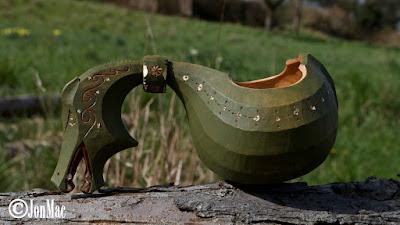For a while now I have wanted to show Sean some of my favourite places on Dartmoor. We took the opportunity of good weather to head on up to the town of 'Princetown', which is situated in the centre of the Moor. The town's history started in 1785 when Sir Thomas Tyrwhitt leased the land from the Duchy of Cornwall. His idea was to improve the land for farming, there was also a need for a prison in the area to house the P.O.W's from the Napoleonic wars who were being held in rotting hulks in Plymouth sound...
I also wanted Sean to have a look at the old mine workings at Eylesbarrow and then sweep down to Drizzlecombe and have a look at some wonderful standing stones dating from the Neolithic. These stones may have been on this site for 9000 years. Modern thinking suggests that a site like this evolved over many years and it is difficult to place the exact timing.
We had a great time hunting around and chatting about all the features we found. Sean has made two films of our day, unfortunately the keen wind of the moor whisked quite a lot of our conversation away, and it may be difficult to follow our drift.
In the first movie we are at Eylesbarrow tin mine. This deep, hard rock mine was in production in the first half of the 19th century. I am trying to explain to Sean to what use a double stone row consisting of granite stones standing about two or three feet from the ground with half moon cut outs on top, was put too.
Here you can make out a pair of stones, they would have been upright at the time, with a half moon socket cut at the head.
If you can, imagine an axle with a cast iron wheel at the centre, the ends of the axle would sit nicely in these two cut outs...
You can just make out a line of paired stones running into the distance. Each would hold an axle with a wheel at it's centre. On top of the wheels would be a long iron bar, resting as it were on the wheels. Now imagine you need to transfer power from a rotating water wheel in the near-by valley up the hill to the mine workings. The water wheel would turn, and connected to this would be one end of the bar via a crank. The bar would be pushed first one way and then pulled the other. The bar can be some hundreds of meters long. At the working end there would be another wheel. Again, via a crank this wheel would then turn. Machinery from the various work shops and crushing stamps could be powered from this spinning wheel.
Here is a good Link describing a flatrod system.
And another Link which gives good information regarding the mine layout and workings...
Here is a plan of the mine...
I remember some years ago watching some people shelter in this sump in the ground. At the time this sump had a nice grassy bottom and it was devoid of water. A good place to get out of the strong winds common on Dartmoor you would think. I remember telling them it wasn't such a good idea. If you find a sump on the moor they are usually full of water, one of the reasons a sump may be dry, especially after rain, is that it is in fact an old choked mine head, the water draining freely through the old rotting collapsed winding gear on top of the shaft. As you can see in this picture, the shaft has collapsed. Lucky the people I spoke to that day heeded my warning. I read some years ago how deep this main shaft is, my memory isn't as good as it was, but I am sure it is over a hundred fathoms...
After the mine I showed Sean some navigation techniques and detailed him to take us to Drizzlecombe. Sean did very well and I have promised him a night-time trip across the moor in the near future, when he will be able to use all the skills he has mustered....
Well, he has set his bearing and off we go....
You can just make out the standing stones on the right of the Barrow or burial mound...
We arrive at Drizzlecombe..
This is a Menhir at one end of the stone row and a photo of Sean standing at the Menhir the other end...
A happy map reading chap...
We had a pick-nick at the barrow or burial mound and Sean found some salad to add to the bread and cheese...
We practised a little micro navigation and found a near-by burial tomb. I believe the deceased was buried in a foetal position...
I felt close to my ancestors as Sean and I discussed what the lay of the land might have looked like over four thousand years ago...
The beautiful landscape of the moor...
We both had a great day and learned even more about what Dartmoor can offer in history and bio diversity...
We had a rummage around Ditzworthy warren house on the return leg and found some interesting foraging...
Before I sign off...
Sean has a new Web page at...
ENJOY...
J
























